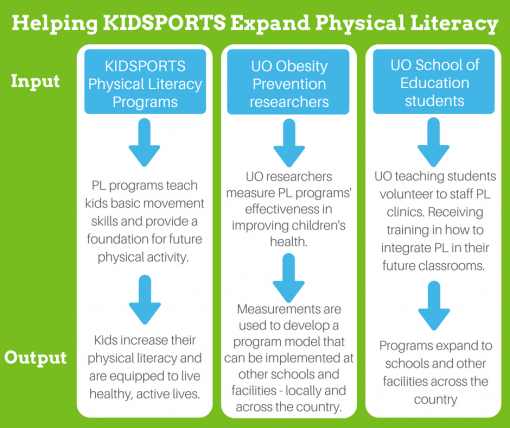Partnerships for Physical Literacy
July 28, 2017
Our ongoing series on physical literacy discusses the basics of physical literacy development. These articles discuss how physical literacy shapes a child’s development and success. Children who lack a firm grasp of basic movement skills have difficulty staying active as they age.
Civic Park will allow KIDSPORTS to expand their current physical literacy programs. This will enable KIDSPORTS to explore how to use PL programs to improve children’s health. It also allows KIDSPORTS to develop their PL programs into a replicable model. Schools and recreational facilities can then use the model to shape their own programs.
KIDSPORTS has instituted a PL pilot program with César Chávez Elementary School. The program includes after school games and activities that build physical literacy. These activities help bridge the gap between intermittent PE times offered in school and the recommended level of 60 minutes of daily physical activity. The goal of these programs is to improve children’s health and prepare them to live active healthy lives.
 If the PL programs are to serve as a model for other facilities, KIDSPORTS must prove the programs’ value. This value is best illustrated through measurable data. Yet, due to the range of factors that influence health, measuring the PL programs’ success can be difficult.
If the PL programs are to serve as a model for other facilities, KIDSPORTS must prove the programs’ value. This value is best illustrated through measurable data. Yet, due to the range of factors that influence health, measuring the PL programs’ success can be difficult.
That’s where the University of Oregon’s Health Promotion and Obesity Prevention Initiative (HPOP) comes in. KIDSPORTS has partnered with HPOP researchers to assess the PL programs’ results. Their work will showcase the benefits that kids receive from increased physical literacy. These benefits include improved confidence and a heightened interest in physical activity. Research conducted at the clinics will help the HPOP to identify factors of obesity. Their research will help them to develop new methods of obesity prevention.
Another partner in these programs is the University of Oregon School of Education. Students in the School of Ed. gain teaching experience by instructing elementary school students in the after school clinics. The U of O students also learn how to structure PE classes that develop physical literacy.
KIDSPORTS’s programs could have a major impact on the health of our youth. Each partner in the physical literacy programs plays a key role in their success. Schools let KIDSPORTS host after school programs so their students can reap the benefits of physical activity. Researchers from the University of Oregon measure program results. This allows KIDSPORTS to illustrate the positive impact children receive by participating. Education students from the U of O volunteer as staff in the PL programs. They also receive training on how to execute similar programs in their future teaching positions. Cross-sector partnerships such as these are key to solving America’s inactivity epidemic. We are eager to help these groundbreaking programs continue to grow at Civic Park!
U of O Health Promotion and Obesity Prevention Initiative
“Activity Helps Kids Stay Fit,” says U of O Clust Hire Elizabeth Budd